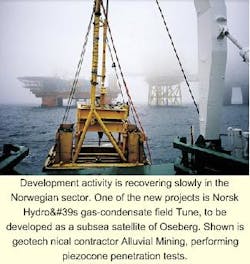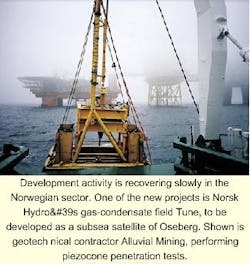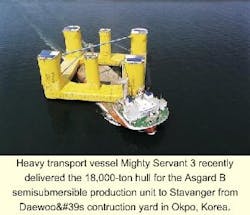Skarv faces further assessment
BP Amoco may need a further appraisal well on its Skarv discovery, 200 km off Norway's Helgeland coast, before committing to a development. The recently completed well 65075-2, drilled by semisubmersible West Alpha in 347 meters of water, proved up further gas in early Jurassic rock - but no more oil. The structure appears to be more complex than anticipated. As a result, oil estimates will likely be scaled down from the previous upside of 500 million bbl to around 200 million bbl.
With so much uncontracted gas already in this area, this was not the ideal outcome for the partners. Nevertheless, they are expected to persevere with studies for a production ship, including a partial gas development - possibly tying in Statoil's nearby Idun Field as a subsea satellite. At Tjelbergodden on the mid-Norwegian coast, Naturkraft (co-owned by Statoil) has applied to build a new gas-fired power plant that would require 1.1 bcm/yr from offshore fields to generate 800 MW. However, the government may scupper the move if it continues to insist on 90% carbon dioxide removal from gas-fired power. This percentage would make the project sub-economic, claims Naturkraft, which has had two other applications for similar plants blocked by the State.
Farther north, Norske Shell was the surprise winner of the deepwater 6305/8 block, awarded by the Energy Ministry in late September. This includes part of Ormen Lange, thought to be the second largest gas discovery on the Norwegian shelf, which extends into PLs 208/209. The operators of those licence, BP Amoco and Norsk Hydro, had also been in contention, but will have to make do instead with equity interests in the block.
Even farther north, Statoil is trying to revive exploration drilling in the Norwegian Barents Sea, where there have been no wells since 1994. Semisubmersible Transocean Arctic has been booked for a campaign next year on its PL 202 licence. Statoil is suggesting a rig-share with other operators with prospects in this region, such as Agip, Elf and Mobil. Statoil may also be appraising its gas-condensate Mikkel Field in Mid-Norway blocks 6407/5 and 6. If further condensate in particular could be proven, it might justify a subsea development through the Asgard or Draugen production facilities.
Norway re-thinking carbon dioxide penalties
Norway's government has finally submitted to pressure from its work-hungry offshore contractors by proposing a 21% cut in carbon dioxide emissions taxes, plus increased royalty relief for mature Norwegian fields. The positive impact on profitability would benefit the planned Tambar field development and Valhall water injection project, according to operator BP Amoco. In time, royalty charges may also be removed for certain declining fields, thought to include Heimdal and Murchison.
Swift action is needed with investment in Norway's oil and gas sector next year, now estimated at NKr 43.6 billion, according to the Central Bureau of Statistics, compared with the NKr59.6 billion forecast a year ago. Exploration spending over 2000 is put at NKr3.7 billion, with NKr20.4 billion allocated for field development and NKr0.4 billion for pipelines.
Cost overruns continue to dog Halten Bank developments. Asgard, the leader in this category, was recently hit by further hikes to the project's gas production semisubmersible (increased by NKr 445 million to NKr 11.4 billion) plus an extra NKr 319 million for re-design of the Midgard Field wells.
Not all Mid-Norwegian news is negative. The Petroleum and Energy Ministry recently launched its 16th licensing round, which comprises 48 blocks and part-blocks in the Norwegian Sea, including deepwater acreage in the Moere South and Voering Basins. Bids are due in by January 31, 2000. Deepwater licences will also be made available in the much-postponed first Faroese licensing round, now scheduled for early next year.
Drilling suffers from NAM's absence
In the northern sector of the Dutch North Sea, Wintershall's A15-3 exploration well has tested gas at 24 MMcf/d. The discovery will be further appraised, according to partner Dana Petroleum. The assumed export option is one of the new pipelines being installed between the NOGAT trunkline and Wintershall's new gas platform in nearby German block A6/B4.
While the NOGAT extension should theoretically stimulate exploration, new drilling starts across the Dutch sector as a whole remain modest, despite the oil price revival. Analysts Wood Mackenzie forecast 16 E&A completions by the end of December.
The analysts predict that capex offshore The Netherlands will recover to total DFl 1.45 billion next year before sliding again in 2002. NAM does have good exploration prospects in the Waddenzee which would be drilled from shore-based locations - but environmental objectors may maintain an embargo on operations.
Talisman eyes expansion option
Post-merger restructuring is creating new opportunities in the UKCS. Ever eagle-eyed Talisman Energy reacted quickest to Elf's sell-off of its equity interests in the Claymore, Piper, Saltire, Chanter and Scapa fields, plus the associated pipeline network and Flotta oil terminal in Orkney. Assuming approval from the UK government and Elf's partners in these fields (Arco, Intrepid, Lasmo, Texaco), Talisman could operate the entire package in March 2000.
In light of its assumed assimilation with TotalFina, Elf is keener to focus on larger-scale operations, such as the current Elgin/Franklin gas-condensate development in the Central North Sea, where it is already studying prospective tie-ins, such as Glenelg.
More bidding can be expected in the southern gas basin, where the European Union has ordered BP Amoco to dispose of Arco's substantial interests as a pre-condition to approving this latest takeover. Merging majors are the dominant players in this region, which might explain the unusually low levels of activity there of late.
Over a longer period, the UK government hopes to persuade operators to develop a further 5.6 billion boe from new and existing UKCS fields, through a series of new technology initiatives. A "son of Crine" body, called Logic, has been developed to promote better practice and greater collaboration across the offshore supply chain. The move followed a report by UK operators this March which predicted a drop of 50% in UKCS investments to £2 billion/yr by 2002.


